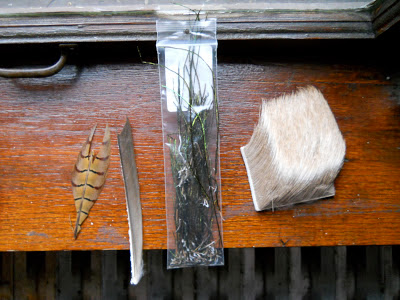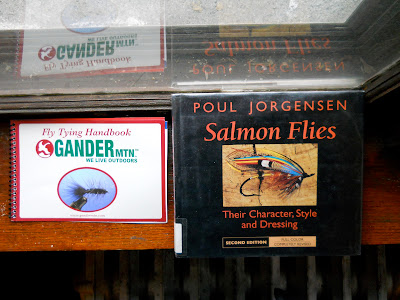 |
| Makeshift mancave |
The tools I use for almost every fly are listed below.
- Tying vise
- Bobbin
- Scissors
- Hackle pliers
- Bodkin
The vise, bobbin and scissors are the most essential. Hackle pliers are really helpful for holding tiny hackle feathers for dry flies, or even just holding larger feathers out of the way while working other materials in. In a pinch, you could probably get by with forceps or a clothespin. The bodkin is used for many things, but you could probably improvise with a safety pin or a sewing needle. Of course you'll need a mug of coffee, and some music too. I find myself listening to a lot of Primus when tying flies, but really, anything southern or kind of twangy or nautical themed makes for good fly tying music. Mastodon's Leviathan album is a good one if you like a little heavier music; it's a concept album based on the novel Moby Dick.
Of course you are going to need some hooks, and some materials for tying. The following is a list of the materials I use most.
- Thread
- Chenille
- Hackle feathers
- Marabou feathers
- Dubbing
- Copper wire
- Beads
- Flashabou
 |
| Fly tying thread and wire |
Chenille is a soft yarn used to make bodies of flies. I use it a lot, because I tie a lot of Woolly Buggers. I always have black, olive and red in my ITEM list. Woolly Buggers are great flies for trout, bass, and many other kinds of fish. If you only ever learn to tie one fly, it should be the Woolly Bugger.
 |
| Assorted fly tying chenille |
Different grades of hackle are used for different flies. Neck hackle is used mostly in tying dry flies; the short, stiff bristles make the fly float on the surface and mimic insect legs in the water. Saddle hackle is usually not considered high enough quality for tying dry flies, so it is usually used in streamers to make the fly appear to be swimming or pulsating in the water. Soft hackle is used in a lot of wet flies. I use saddle hackle mostly, because it is used in Woolly Buggers. I haven't tied a lot of dry flies.
 |
| A neck of red hackle in the center, Black and grizzly saddle hackle on either side |
 |
| Marabou is very soft |
Dubbing is used in a lot of flies. there are going to be nymphs, dries, streamers, and wet flies that all call for dubbing. Dubbing is fur from soft furred animals that is wound around the tying thread and used to build up the body of the fly. In early fly tying, most salmon flies called for seal fur-- good luck finding that! Dubbing today is made from the fur of animals like opossums, beavers and rabbits-- I've been tempted to try using hair from my cat, but haven't yet. I use dubbing most often in tying scuds. Scuds are tiny freshwater shrimp that fish regularly feed on. Scuds are fairly simple to tie, require only a few materials, and very effective for trout and bass when dead drifted.
 |
| Olive, grey, and tan dubbing |
Beads are used as the heads of nymphs and streamers. They add a little bit of weight to sink the fly faster, and add flash and color. I'm not sure, but I think the idea of using beads is a fairly new innovation to fly tying. In earlier times, (and even still) some streamers called for lead wire to be wrapped around the hook shank. My fly tying kit even came with some lead wire for use in Woolly Buggers. But with the added flash and color of bead heads, there is no need for anglers to be further polluting our streams by adding lead to the ecosystem. Not only are beads safer for the environment, they also seem to improve the effectiveness of most flies when used in appropriate sizes. I keep several shapes, sizes and colors. Use heavier beads on big Woolly Buggers in swift currents and deep pools, smaller beads can be used on tiny nymphs and scuds dead drifted in slower water.
 |
| Assorted bead heads and flashabou |
Flashabou is a synthetic material that has a prismatic or iridescent pearly reflective quality. A few strands of flashabou in the tail of a Woolly Bugger may help attract fish to your fly. It doesn't take a lot, I've had the package pictured above for about three years and I've hardly used any! A package of flashabou is a good investment.
I have some other materials that are used in particular flies that I don't tie so often, but it's nice to have them if you need them. Pheasant tail feathers are used in tying Pheasant Tail Nymphs and Copper Johns. Pheasant Tail Nymphs are highly effective, but they are not easy to tie, at least for me. They're tiny, and they test my patience-- but a Pheasant Tail was the first fly I tied that I caught a trout on! Peacock Herl is used in a lot of flies, and fish love it. Anything with peacock herl in it is going to be an effective fly. You can tie peacock herl on a hook by itself and it will catch fish. Common flies that call for peacock herl are the Royal Coachman, Pheasant Tail Nymphs, and Prince Nymphs. I have some goose biots because Prince Nymphs call for two white goose biots. However, the goose biots I have are from Canada geese. I found them in the park, so I'll improvise. Finally, I have some elk hair. Elk hair is used in a legendary dry fly, the Elk Hair Caddis. When you want to catch fish on a dry fly, the Elk Hair Caddis is probably what you would tie on first if there isn't any kind of hatch to match. The Elk Hair Caddis is quite tricky to tie. I haven't quite gotten the hang of it yet. The hair is very stiff and it's hard to get used to working with it. There are other flies that use elk hair as well, like the Muddler Minnow. I tried tying a Muddler Minnow. It didn't turn out great, and I never caught a fish with it.
 |
| From left to right: Pheasant tail, goose biot, peacock herl, and elk hair |
It's also helpful to have some sort of a book to explain how to tie flies. The Milwaukee Public Library has a pretty good selection of fly fishing and fly tying books at the central location. I recently checked out a book titled Salmon Flies: Their Character, Style and Dressing by Poul Jorgensen. The book is beautiful with some of the most intricate flies I have ever seen, but it requires complicated techniques and materials from exotic animals. There is a chapter called "Simple Strip-Wing Flies" that explains how to tie the Blue Charm in 43 steps, using 11 materials! I think there was a fly in the book that called for moogle dubbing, Cockatrice pinion, Chocobo hackle and Phoenix Down! The book is so complicated that to a fly tyer of my skill level, it reads like a work of fiction. Most flies are far simpler. My kit came with a handbook that gave instructions on how to tie flies that will catch fish using just two or three materials.
If you're looking to get into tying, the materials that you will probably get the most use out of are chenille, some hackle, dubbing and marabou. With just those few materials, you can tie a few very successful flies. You can get them at any Gander Mountain or Cabela's. If you live in the Milwaukee area, you can get great materials, good advice, and even take a tying class at The Fly Fishers. In my next post, I'll demonstrate some basic fly tying techniques, and give instructions on how to tie an effective fly using only two materials.
 |
| The extremes of fly tying |

No comments:
Post a Comment